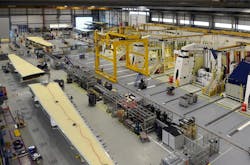Internet of Things Gains Real World Traction
Manufacturing is the sector most primed for the value proposition of the Internet of Things (IoT). Why? Because of all the data that’s been captured and is constantly being captured by industry.
More than many other such pronouncements, this statement, made by Jim Robinson of Intel’s Internet of Things Group, during a panel discussion at National Instruments' NI Week 2014, clarifies why the IoT has moved from being the next big idea to the next big way of doing business in manufacturing.
As Robinson pointed out in his comments during the panel discussion, there’s been a focus on the general IoT concept for more than 30 years now, though its gone by many different names (most famously in the manufacturing space—machine to machine or M2M). The Internet of Things just happens to be the most recent of those names.
“It’s an evolution of the computer infrastructure development that’s been going on for decades,” he said. What’s different now is the “ubiquitous continuity” we’re able to achieve by connecting different systems to get “useful information from billions of devices … along with the continuation of Moore’s Law.”
The “ubiquitous continuity” Robinson spoke of has been brought about by the increasing use of Wi-Fi and cellular in industrial applications. As Ted Rappaport, director of NYU Wireless and professor of electrical engineering, who also was a member of the NI Week panel, pointed out—there is a renaissance in wireless coming. What we’re seeing now is only the very beginning.
Wireless is quickly moving beyond the Wi-Fi and cellular speeds we’ve been confined by, he said. “We’re about to see that change as we get speeds into the hundreds of gigahertz, which will give us orders of magnitude more bandwidth to enable greater use of IoT.” Rappaport said current research for near-term applications are leading to 5G cellular by 2020.
Aside from technology companies like Intel, GE, and Cisco, all of which have made a good bit of noise about how they’re putting IoT concepts to work in their own manufacturing operations, Airbus announced that it too has come quite a ways in applying the IoT to create the Airbus Factory of the Future.
At the NI Week event, Bernard Duprieu and Sebastien Boria of Airbus explained Airbus’s Factory of the Future project.
“Factory of the Future is a research project to deploy emerging technologies to increase quality and productivity,” said Boria. “Novel approaches to production processes using cyber-physical systems and big data analytics are major factors in our research here.”
The most recent advance in Airbus’ Factory of the Future project involves the incorporation of digital tracking and monitoring using RFID (radio-frequency identification) technology to increase industrial operations efficiency. As Duprieu and Boria showed during their presentation, Airbus has attached RFID tags to objects such as aircraft components and tools. These tags can then be read automatically from distances of up to 100 meters using special glasses (similar to Google Glass) through which Airbus can track and visualize production processes in real-time. According to Airbus, this visualization technology has been deployed on the A330 and A350 final assembly lines in Toulouse, France, and on the A400M wing assembly operations in the UK.
Boria explained that Airbus uses National Instruments’ sbRIO for the glasses’ embedded computing device, which is programmed using LabView RIO.
“The Airbus Factory of the Future is not necessarily a green field site,” Boria pointed out. “We didn’t invent anything for this, we just put new things together using existing technology. Our goal is to connect humans to humans and humans to machines.”
Intel’s Robinson expanded on Airbus’ Factory of the Future research noting the key point of how Airbus, with its glasses concept, is moving analysis to the source. “The success of the Internet of Things hinges on analytics, but first we must be able to release data securely from devices for analysis,” he said. “Some applications need analysis on or as near to the device as possible. We can’t move all that data onto cloud for analytics. We need real-time, deterministic analytics on the devices or at the edge of network.”
Airbus’ project is showing how that can be done with existing technology on today’s factory floor.
About the Author
David Greenfield, editor in chief
Editor in Chief

Leaders relevant to this article:
